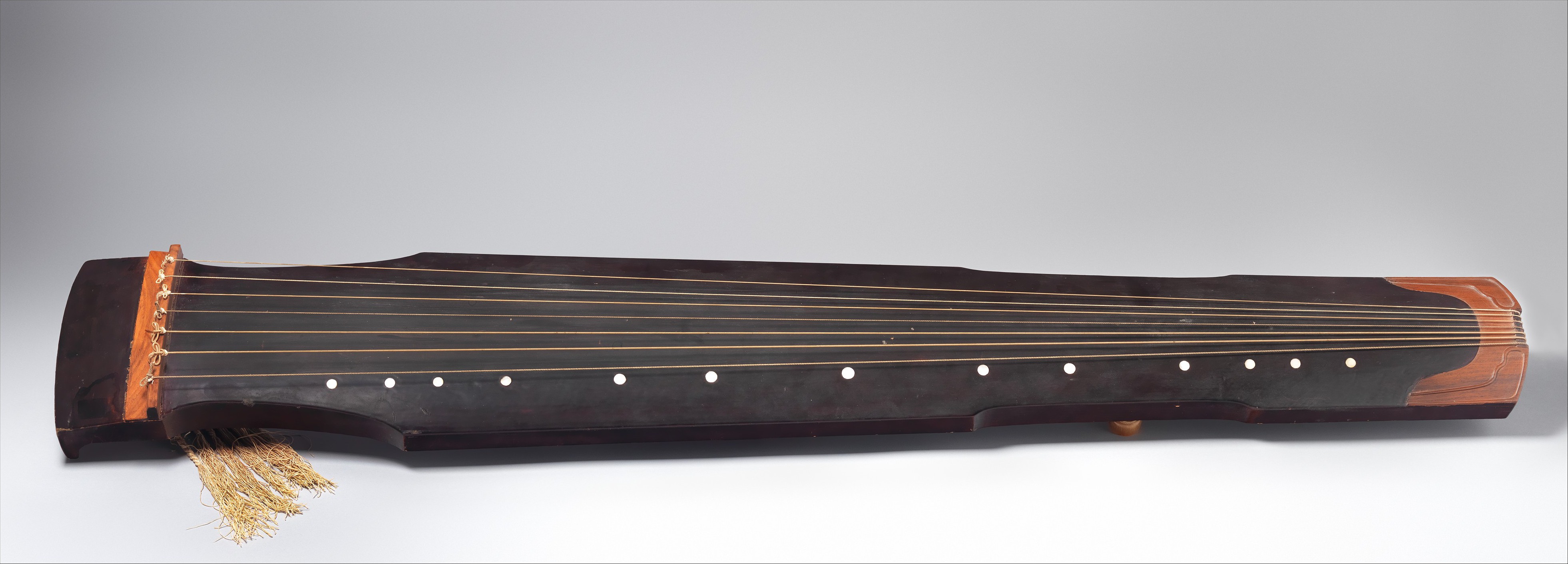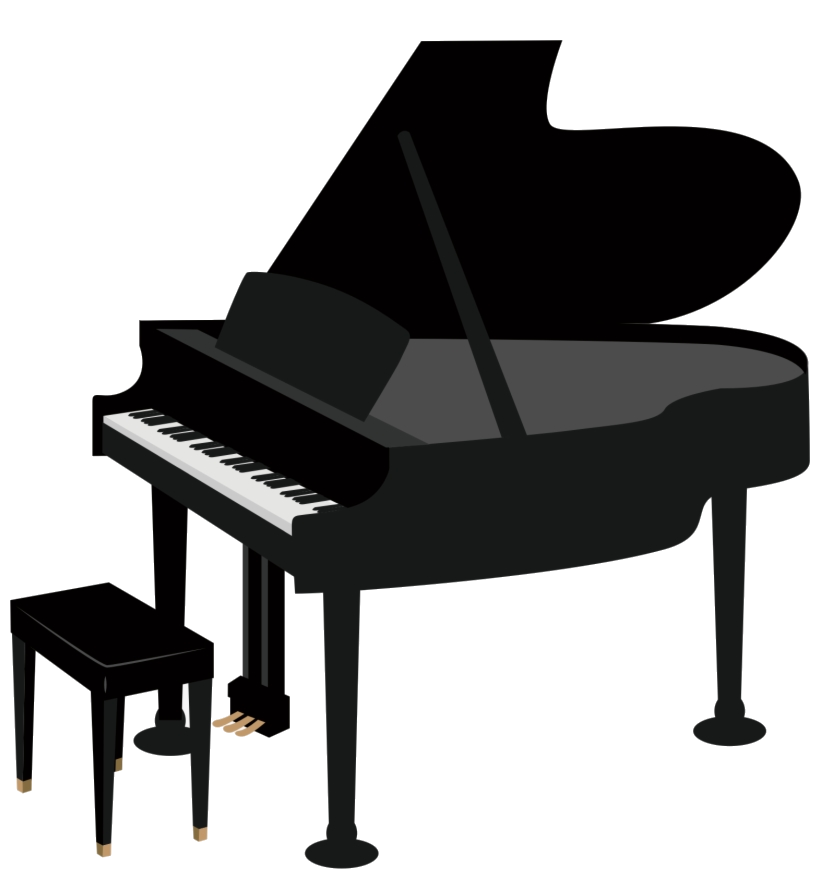
古琴,原称琴,又称瑶琴、玉琴、五弦琴和七弦琴,是中国的拨弦乐器,有三千年以上历史,属于八音中的丝。古琴音域宽广,音色深沉,余音悠远。自古“琴”为其特指,于1920年代起为了与钢琴区别而改称古琴,[1]本文统称琴。初为五弦,汉朝起定制为七弦,且有标志音律的13个徽,亦为礼器和乐律法器。 琴是中国古代文化地位最崇高的乐器,[2]有“士无故不撤琴瑟”[3]和“左琴右书”[4]之说。位列“琴棋书画”四艺之首,被文人视为高雅的代表,亦为文人吟唱时的伴奏乐器,自古以来一直是许多文人必备的知识和必修的科目。[5]伯牙、子期以“高山流水”而成知音的故事流传至今;[6]琴台被视为友谊的象征。大量诗词文赋中有琴的身影。现存琴曲3360多首,琴谱130多部,[7]琴歌300首。主要流传范围是汉文化圈国家和地区,而西方也有琴人组织的琴社。
Die Qin (chinesisch 古琴 gǔqín, W.-G. ku-ch'in,  guqin?/i) ist eine Griffbrettzither, die in der klassischen chinesischen Musik gespielt wird. Sie unterscheidet sich von anderen asiatischen Zithern durch das Fehlen der unter die Saiten geschobenen Stege wie z. B. bei der vietnamesischen Tranh oder der chinesischen Guzheng. Bei ihr wird der Ton wie bei einem Lauteninstrument mit den Fingern abgegriffen, wobei die Bünde durch Griffmarken ersetzt sind.
guqin?/i) ist eine Griffbrettzither, die in der klassischen chinesischen Musik gespielt wird. Sie unterscheidet sich von anderen asiatischen Zithern durch das Fehlen der unter die Saiten geschobenen Stege wie z. B. bei der vietnamesischen Tranh oder der chinesischen Guzheng. Bei ihr wird der Ton wie bei einem Lauteninstrument mit den Fingern abgegriffen, wobei die Bünde durch Griffmarken ersetzt sind.
古琴(こきん、クーチン、拼音: gǔqín)は、中国の古い伝統楽器。七弦琴(しちげんきん)・瑶琴(ようきん)とも呼ぶ。3000年の歴史がある撥弦楽器で、八音の「糸」に属し、7本の弦を持つ。箏などと違い、琴柱(ことじ)はなく徽(き)と呼ばれる印が13あり、これに従い、左指で弦を押さえて右指で弾く。古琴演奏技は、2003年、ユネスコの無形文化遺産保護条約に基づく「人類の無形文化遺産の代表的な一覧表」に掲載され、2009年9月に無形文化遺産として正式登録された[1]。
古琴は中国の文人が嗜むべきとされた“琴棋書画”の一番目である。孔子、諸葛孔明、竹林の七賢の嵆康、陶淵明、白居易など、歴史上著名な多くの文人によって演奏された。日本でも菅原道真、重明親王が学んだことが知られる。「君子左琴」「右書左琴」「伯牙絶弦」「知音」など、琴にまつわる故事成語も多い。
The guqin ([kùtɕʰǐn] ( listen); Chinese: 古琴) is a plucked seven-string Chinese musical instrument. It has been played since ancient times, and has traditionally been favoured by scholars and literati as an instrument of great subtlety and refinement, as highlighted by the quote "a gentleman does not part with his qin or se without good reason,"[1] as well as being associated with the ancient Chinese philosopher Confucius. It is sometimes referred to by the Chinese as "the father of Chinese music" or "the instrument of the sages". The guqin is not to be confused with the guzheng, another Chinese long stringed instrument also without frets, but with moveable bridges under each string.
listen); Chinese: 古琴) is a plucked seven-string Chinese musical instrument. It has been played since ancient times, and has traditionally been favoured by scholars and literati as an instrument of great subtlety and refinement, as highlighted by the quote "a gentleman does not part with his qin or se without good reason,"[1] as well as being associated with the ancient Chinese philosopher Confucius. It is sometimes referred to by the Chinese as "the father of Chinese music" or "the instrument of the sages". The guqin is not to be confused with the guzheng, another Chinese long stringed instrument also without frets, but with moveable bridges under each string.
Traditionally, the instrument was simply referred to as the "qin" (琴)[2] but by the twentieth century the term had come to be applied to many other musical instruments as well: the yangqin hammered dulcimer, the huqin family of bowed string instruments, and the Western piano are examples of this usage. The prefix "gu-" (古; meaning "ancient") was later added for clarification. Thus, the instrument is called "guqin" today. It can also be called qixian-qin (七絃琴; lit. "seven-stringed qin"). Because Robert Hans van Gulik's book about the qin is called The Lore of the Chinese Lute, the guqin is sometimes inaccurately called a lute.[3] Other incorrect classifications, mainly from music compact discs, include "harp" or "table-harp".
The guqin is a very quiet instrument, with a range of about four octaves, and its open strings are tuned in the bass register. Its lowest pitch is about two octaves below middle C, or the lowest note on the cello. Sounds are produced by plucking open strings, stopped strings, and harmonics. The use of glissando—sliding tones—gives it a sound reminiscent of a pizzicato cello, fretless double bass or a slide guitar. The qin is also capable of many harmonics, of which 91 are most commonly used and indicated by the dotted positions. By tradition, the qin originally had five strings, but ancient qin-like instruments with 10 or more strings have been found. The modern form has been standardized for about two millennia.
There are more than 3,360 known surviving pieces of guqin music from ancient and imperial periods. On 7 November 2003, UNESCO announced that the Chinese guqin was selected as an Intangible World Cultural Heritage. In 2006, guqin was listed in the List of National Non-material Cultural Heritage in China. In 2010, a Song period guqin was sold for $22 million, making it the most expensive musical instrument ever sold.[4]
Le guqinÉcouter (Chinois: 古琴; Pinyin: gǔqín ; EFEO : kouts'in; littéralement « instrument à cordes ancien »), ou qin, est un instrument de musique traditionnel chinois à cordes pincées de la famille des cithares (中華絃樂噐). « Le Guqin et sa musique » ont été inscrits par l'UNESCO en 2008 sur la liste représentative du patrimoine culturel immatériel de l’humanité (originellement proclamé en 2003)1.
Il qin (琴), o guqin (古琴), è uno strumento musicale cinese appartenente alla famiglia degli strumenti a corda detti cetre o salteri a tavola. Il vocabolo è traslitterato anche ch'in. Il significato del termine guqin è "antico strumento a corda" e l'origine dello strumento risale a più di duemila anni fa. Il qin è fornito di sette corde di diverso diametro la cui accordatura più classica (zheng diao) corrisponde - a partire dalla corda più bassa - a do, re, fa, sol, la, do (ottava), re (ottava); il corpo in legno cavo funge anche da tastiera, e la tastatura viene indicata da bottoni di avorio intarsiati sul lato della cassa.[1]
Il qin è disposto in posizione orizzontale, come la maggior parte delle cetre a tavola dell'asia orientale. Si pizzicano le corde con la mano destra, mentre la sinistra usa le tecniche del glissando e degli armonici. Il suono melodioso e caldo conferisce all'ascoltatore un senso di raccoglimento e meditazione.
El Guqin léase [Ku-Chin]( escuchar) (en chino simplificado, 古琴; pinyin, gǔqín; Wade-Giles: ku-ch'in , lit: antiguo instrumento de cuerda) es el nombre moderno de un instrumento musical chino de siete cuerdas de seda, de la misma familia de la cítara, la cual consiste en una caja oblonga de 120 cm de largo, por 15 cm de ancho y 5 cm alrededor en sus bordes, elaborada con la madera del catalpa ovata o china (Catalpa kaempferi) en su tablero y de la firmina platanifolia (Firminia platanifolia) en su caja de resonancia. (中華絃樂噐/中华弦乐器). El guqin ha sido interpretado desde los tiempos antiguos, como instrumento preferido de eruditos e intelectuales por su carácter sutil y refinado. Los chinos lo llaman a menudo 「國樂之父/国乐之父」, que significa «padre de la música china».
escuchar) (en chino simplificado, 古琴; pinyin, gǔqín; Wade-Giles: ku-ch'in , lit: antiguo instrumento de cuerda) es el nombre moderno de un instrumento musical chino de siete cuerdas de seda, de la misma familia de la cítara, la cual consiste en una caja oblonga de 120 cm de largo, por 15 cm de ancho y 5 cm alrededor en sus bordes, elaborada con la madera del catalpa ovata o china (Catalpa kaempferi) en su tablero y de la firmina platanifolia (Firminia platanifolia) en su caja de resonancia. (中華絃樂噐/中华弦乐器). El guqin ha sido interpretado desde los tiempos antiguos, como instrumento preferido de eruditos e intelectuales por su carácter sutil y refinado. Los chinos lo llaman a menudo 「國樂之父/国乐之父」, que significa «padre de la música china».
El nombre tradicional era qin 「琴」, que también puede ser escrito 「琹」, 「珡」 y de otras maneras antiguas, pero desde el siglo XX la palabra fue aplicada para referirse también a otros instrumentos musicales. El yangqin 「揚琴/扬琴」, el huqin 「胡琴」, ambos instrumentos de cuerda, y el piano occidental (chino tradicional: 鋼琴; chino simplificado: 钢琴; pinyin: gāng qín; que significa «instrumento de cuerda de acero») son algunos ejemplos del uso de la palabra “qin” en otros instrumentos, por eso se adhirió el prefijo "gu-" 「古」; que significa “antiguo”, para la diferenciación. También se lo llama qixianqin (「七絃琴」; “instrumento de siete cuerdas”). No debe ser confundido con el guzheng 「古箏/古筝」, otro instrumento de la familia de la cítara, también sin trastes y con puentes bajo cada cuerda. Debido al nombre del conocido libro de Robert Hans van Gulik The Lore of the Chinese Lute,1 sobre el guqin, este es frecuente y erróneamente llamado laúd. Otra denominación incorrecta, encontrada sobre todo en discos compactos de música, es por ejemplo el de “arpa".
El sonido que produce el guqin es bajo y muy suave, con un rango de unas cuatro octavas. Su tono más bajo es de dos octavas por debajo del do central del piano. Tradicionalmente tiene cinco cuerdas, pero se han encontrado instrumentos similares de la antigüedad con diez cuerdas o más. La forma moderna de siete cuerdas ha sido la estándar durante dos milenios. Muchas personas que tocan el guqin o que han escuchado a alguien tocándolo afirman que la música de aquel instrumento es muy similar a la del género blues.
El guqin y su música fue proclamado en 2003 e inscrito en 2008 en la Lista representativa del Patrimonio Cultural Inmaterial de la Humanidad de la Unesco.2
Цисяньци́нь (кит. 七絃琴, ци «семь», сянь «струны», цинь «струнный инструмент»), также называется «гуцинь» (gǔqín 古琴), или «старинный цинь»[2] — китайский 7-струнный щипковый музыкальный инструмент, разновидность цитры (см. также цинь).






 History
History






